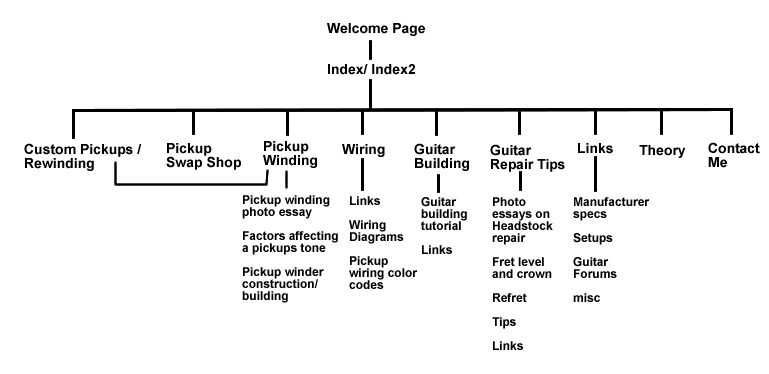Factors affecting how a pickup sounds
Magnets:
It is often said that ceramic magnets are brighter than alnico,
but that isn't entirely correct. What makes a magnet "brighter"
than another is it's strength. A stronger magnet will be brighter.
Because ceramic is so much cheaper than alnico, Alnico in
grades above 5 (or8) is rarely ever used. High output pickups
often use ceramic magnets. Ceramic magnets are actually weaker
for a given grade/size after a certain point. In the sizes
used for pickups, Alnico is weaker. A pickup which utilizes
alnico polepieces can have different poles made of different
strength magnets to accentuate or minimize certain characteristics.
Pickups which have a bad sound or string may have a magnet
which is not matched to the others; rarely one polepiece will
actually be upside down.
Page with Alnico
magnet properties (link to other magnet materials are
there as well)
Here's a page with "magnetic
design considerations" includes info on demagntization
factors. some say alnico will demagnitize if ground or filed
due to the heat. As shown on this site, the maximum "practical
operating temperature for alnico is 540*C (1004*F). I don't
think you'll get it that hot with a file or a grinder...
A trick I learned when grinding
hardened and temepered steels was to keep the fingers in close
proximity. If it gets too hot for the fingers, dip it in water.
It's still WAY below any critical temperature (critical temp
for some steels and hardness/temper is around 350*F)
Here's a page of FEMM
simulations showing magnetic fields for a few different
pickup types
Wire: The finer the
wire the fewer highs pass through. Finer wire also has a higher
resistance for a given length. For this reason a pickup wound
to 6k with 43awg wire will have less output than a pickup
wound to 6k using 42awg wire. Regardless of what has been
said I do no believe there is any difference based upon type
of insulation alone. However, wire with a heavier insulation
(i.e. "double build") will result in a wider coil
at the same resistance/output. See "shape of coil"
There is a characteristic
of wire called "skin effect" which is more pronounced
in smaller diameter wires due to thier higher restance. "Skin
effect" is where the higher frequencies travel along
the surface of the wire rather than travel thru the center
of the wire. This leads to that "brittle" characteristic
of high output pickups which must be wound with the finer
wires...
Number
of windings: The greater the number of windings the
greater the capacitance and inductance of the pickup. Because
of this more low end is generated along with an increase in
output. Additionally, more windings will make a slightly wider
coil, see "shape of coil" below.
Grounding: If a pickup has a metal baseplate or cover, and
it is grounded, some of the highest frequencies will pass
to ground by a means called "flux line coupling"
Metal base/ cover: if
the plate is magnetic, and not grounded it will increase the
capacitance and inductance of the pickup much like more windings
do. The metal will also add lows/mid lows.
Shape of the coil: A
coil which is taller and narrower will be clearer, more focused
and slightly brighter than another coil which is shorter and
wider if they have the same output. This is because the shorter
wider pickup is sensing a wider section of the string, which
gives it more variance in the signal it's sensing (due to
variance in oscillation size/ pattern of the string along
the length of string sensed)
Magnet placement: How
the magnet(s) are placed has an effect on the field of the
pickup and therefore the signal generated. An example of this
is a P-90 type pickup which has the polarity of the magnets
repelling each other in comparison to a similar pickup with
the polarities attracting each other. The opposing polarity
pickup seems to be less focused.
Magnet age: Some say
alnico weakens with age, and this relates to magnet strength
as previously explained. (Magnet manufacturers claim a loss
of strength at a rate of aprox .2-2% / 100yrs) However, some
manufacturers are "aging" magnets by heating. I
have found through testing that this type of "aging"
does NOT weaken the magnet (there is a point at which it will,
but it's almost an "all or none" situation) What
it does do is "temper" the magnet (alnico) relieving
internal stresses. My testing has shown that before tempering
there was often an unevenness of strength between magnets
of the same "rating", i.e.alnico5, even between
the two poles of the same magnet. The tempering almost always
equalized the strength of the two poles of the same magnet,
and lessend the variance between magnets of the same rating.
However, it was not uncommon to still find some variance (I
believe significant). For this reason I now temper all alnico
magnets and test them for strength. As a side note, information
provided by a magnet manufacturer indicated that tempering
in this manner will make the magnet less susceptible to outside
interference.
Coil Age: Much of the
characteristics which are attributed to the aging of the magnets
may actually be due to the aging of the coil wire. This makes
more sense based upon tests and experience, and what is known
about magnet aging. The older insulation (formvar and enamel)
will get hard and brittle with age, this would also "stiffen"
the coil windings, changing their characteristics slightly.
Also note that the older "Lacquer potting" on some
pickups tends to break down significantly with age. This will
have a definite effect.
Winding pattern: machine
wound pickups have a very even wind pattern; custom wound,
hand wound and very old pickups generally have a much less
regular winding pattern. This is called "scatterwinding";
what happens is every time the wire crosses, the flux line
generated also crosses and couples making one larger irregular
flux line. I believe this causes the pickup to react as one
large "whole" instead of more like many finer flux
lines interacting with and reacting to each other. I believe
this is why scatterwound pickups almost never have "brittleness"
even if they are bright, scatterwinding and the flux line
couple helps destroy the "skin effect".
Besides breaking up "skin
effect" it also causes something called "distributed
capacitance" which is where the capacitance of one winding
is spread to other windings within the coil. Scatterwinding
causes the capacitance to be "spread" across many
more windings. It also minimizes "mutual (self) inductance"
which is where each individual winding picks up and amplifies
a portion of signal from adjacent windings.
Potting: let me start
by saying this is all subjective and I don't fully understand
everything here (well, I don't have any hard data to back
it up)...First off, a properly wound pickup doesn't need potted(fact).
An unpotted pickup is going to be more "musical"
than an unpotted one if wound properly; however, it will also
be more prone to damage and will wear out more quickly. A
pickups windings actually move w/ vibration as the electomagnetic
field moves and w/ the body vibration to a small extent. That's
why unpotted is more musical, however if the windings are
too loose the pickup can be microphonic, even to the point
of picking up your voice (I suspect the voice somehow causes
the windings to move ever so slightly). Potting prevents the
vibration and thus eliminates the risk of microphonics. The
harder the potting material the more "high fi" the
pickup will sound. Thats why epoxy pottedpickups are often
considered sterile, but this lack of overtones helps those
same pickups stay defined in very high gain situations. Also,
the potting material will effect the pickups "resonant
peak" and can actually change the point and frequencies
at which the pickup "breaks up" or feeds back.
Now, what is often called microphonic isn't, it's a pickup
squeeling or feeding back due to a loose part somewhere, any
air gaps between surfaces can vibrate and cuase the squeeling,
very often it's the pickup cover. It's also a common problem
w/ tele bridge pickups because the copper plate underneath
becomes loose. Potting fills the voids and prevents vibration
stopping the squeeling. From a production standpoint, it is
just too easy to have problems without potting especially
if the pickups are going to be used in a very loud/ very high
gain environment, so most pickups are potted from the factory
(the "good ones" anyways, there are a few exceptions)
My solution is a "partial potting" of the coil,
only isolating the outer windings and allowing the inner ones
to move
Most of these factors are not huge on thier own (in general,
magnet strength being one exception, it's pretty significant.
Coil shape /size is another). But combining them will have
a significant impact on how the pickup sounds. All of these
factors must be considered and balanced when trying to achieve
a particular "sound". It is easier to start from
a known point, and make minor modificatins to that than it
is to "start fresh" because there are too many interactions
going on to determine "which" factor(s) made the
difference.
|

